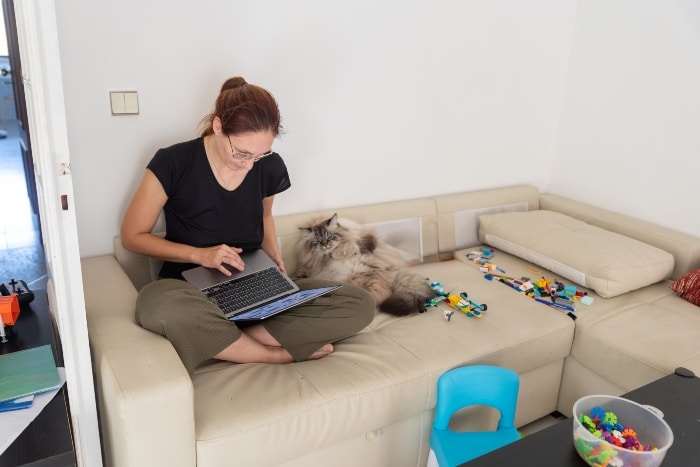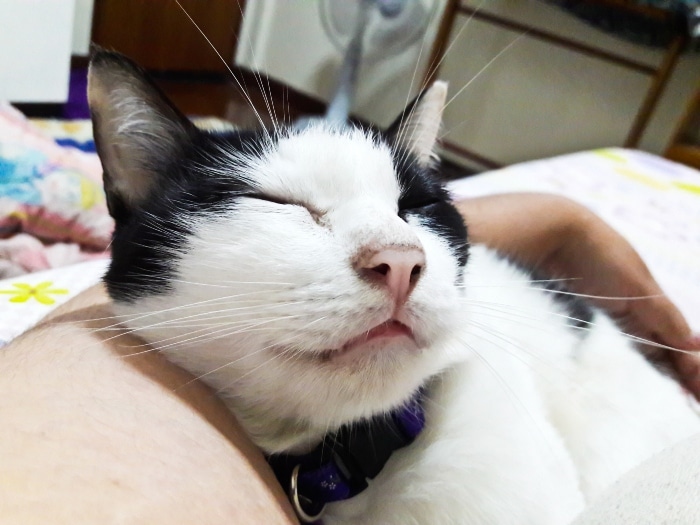Are you looking for advice on how to introduce a cat to a newborn? Introducing a cat to a newborn can be done smoothly with the right preparation and patience. Here’s a step-by-step guide to help your cat feel comfortable and minimize stress for both your pet and the baby.
I had a cat when my second son was born. I heard from people to watch the cat to make sure it doesn’t steal the baby’s breath. Thank goodness this is an old wives tale and it isn’t true. However, you do want to supervise your cat around the baby. Keep reading to learn how to introduce a cat to a newborn!

Prepare Your Cat Before the Baby Arrives
Cats tend to thrive on routine and a baby can easily disrupt that. I don’t recall that my cat had any issues when I brought home my baby from the hospital. But some cats are pickier than others. Here are some things you can do to make the transition go well.
- Gradual Routine Changes: Cats are sensitive to changes in their environment. A few weeks before the baby’s arrival, begin adjusting your routine to match what it will be like when the baby arrives (e.g., different feeding times or playtimes).
- Introduce Baby Scents: Let your cat become familiar with baby-related smells. Try using unscented baby wipes or lotions in the baby’s area, or place baby items where your cat can sniff them.
- Sound Exposure: Play recordings of baby sounds (like crying or babbling) at a low volume and gradually increase it. This helps your cat acclimate to new sounds without getting startled.
Create Safe Spaces for the Cat
Cats need to have a safe space to retreat when they feel nervous or in danger. Make sure that you set up several spaces that are safe just for your cat.
- Designated “Cat-Only” Zones: Make sure your cat has places it can escape to that are off-limits to the baby. Cats need their own space to feel safe and retreat when they want alone time.
- Vertical Spaces: Cats feel secure when they can observe from a height, so consider adding cat shelves, perches, or even a cat tree near areas where you might spend time with the baby.
Slowly Introduce the Scent of the Newborn
Have your spouse, significant other or a family member to bring something home that your baby has been around.
- Bring Home a Blanket First: After the baby is born but before you bring them home, take a baby blanket or a piece of clothing the baby has used and let your cat sniff it. This can help your cat get familiar with the newborn’s scent gradually. Then allow your cat to sniff the item and learn baby’s scent before the baby comes home from the hospital.
The First Meeting
Keep the first meeting short and sweet. Do allow your cat to sniff the baby. Hopefully, your cat will recognize the baby’s scent.
- Stay Calm and Keep It Short: When you bring the baby home, let the cat observe from a distance. Keep the initial introduction brief and don’t force interaction. Speak calmly to both the baby and the cat, and reward your cat for calm behavior.
- Use Treats and Praise: Keep some treats on hand to reward your cat for calm and relaxed behavior near the baby. This creates a positive association with the baby’s presence.

Establish Boundaries
Always set up safe boundaries with your cat so that your baby remains safe. You don’t want your cat to accidentally injure your newborn. or end up in your baby’s sleeping space.
- Teach “No-Go” Zones: Set up a bassinet, crib, or any other baby sleep area with a barrier, like a screen door or a cat net, to prevent the cat from entering those spaces.
- Supervise Interactions: For the first few months, it’s best to supervise interactions to ensure the cat remains gentle and the baby is safe.
Keep Up with Your Cat’s Routine
Like I mentioned earlier, cats tend to thrive on routine so it is important to keep up with it after baby comes home from the hospital.
- Consistency is Key: Maintaining your cat’s regular schedule of feeding, play, and attention helps prevent feelings of neglect or jealousy. When cats know they still have their special place, they’re more likely to accept the new family member.
Recognize and Address Stress Signs
Do watch your cat for signs of stress.
- Watch for Behavioral Changes: Stress signs in cats include hiding, reduced appetite, or excessive grooming. If your cat seems stressed, give them extra reassurance or try calming aids like Feliway diffusers.
With patience and these gradual steps, many cats come to accept or even bond with the baby. If your cat is especially sensitive, some extra time or even support from a vet or animal behaviorist may help.


